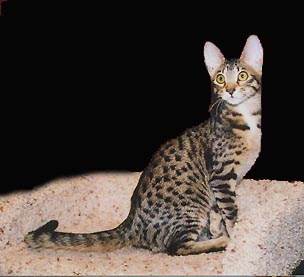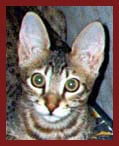The Serengeti Cat---
---a new domestic breed

Created by Karen Sausman of Kingsmark Cattery in California in 1994, the Serengeti Cat breed is accepted for registration with TICA and showing in the Advanced New Breed classes. I decided to create a domestic breed of cat that was partially modeled on the beautiful African Serval. However, unlike the breed known as Savannah cats, Serengeti cats have NO serval blood.
What breeds were used to create Serengeti Cats?
Serengeti cats have been created using primarily Oriental Shorthair Cats and Bengal Cats, but individuals of other breeds could be used if they have something to offer.
Are Servals used to create Serengeti Cats?
No, because of the genetic diversity of the founding breeds - Bengals and Oriental Shorthairs - there has been no need to introduce serval blood into the Serengeti Cat.
The current gene pool for Bengals is quite large containing both domestic and wild genes from many individuals of at least 8 different forms: the Asian Leopard Cat, the British Shorthair, unregistered domestic shorthair, the "Indian Mau", the Ocicat, the Egyptian Mau, the Abyssinian, and the Burmese (Bombay). Some even carry Persian bloodlines. The Oriental Shorthair was created from domestic shorthairs and Siamese.
What does the Serengeti Cat look like?
The Serengeti Cat is a medium boned, long legged, domestic cat slightly resembling a long-legged African wild cat. There have been no servals used to create Serengeti Cats.
The Serengeti Cat is a clear yellow to gold cat with a pattern of
distinct widely spaced black spots. Their stomach, ventral surfaces, whisker
pads, chin, throat and jowls can be a little lighter in color. The coat
is short, thick, and moderately soft. Since melanistic servals are known to
exist. Serengeti Cats may also be cold gray with black spots, silver with black
spots or solid black.
The ears of the Serengeti Cat are very large, rounded on the end, and placed
directly on the top of the skull with black backs and a "eye-spot".
Eyes can be gold to amber; green is acceptable.
The conformation of the Serengeti Cat is more similar to the Oriental Shorthair.
The obvious differences is that the Serengeti Cat is being bred for larger
bone, longer legs and a much more upright and larger ear. Their posture
is more upright with their heads held high on a long, thick neck. This
conformation sets them apart form both the Bengal Cat, which is supposed
to have a long, sinuous body and very small ears, and the Oriental Shorthair,
which is supposed to have its ears set more on the side of the head and
a have a more elegant, finer boned body. Also, "glitter", which
has been introduced into the Bengal Cat from the "Indian Mau",
is acceptable in the Serengeti Cat.
How large are Serengeti Cats?
Males can weigh between 10-15 pounds and females weigh between 8-12 pounds.
How do Serengeti Cats behave?
The temperament of the Serengeti Cat is open, self-assured
and friendly. If introduced properly they should get along well with other
pets. They are active and can be vocal, but not as much as their oriental
ancestors. They love to climb and chase toys and will play for hours.
Can Serengeti Cats be shown in cat
shows?
Serengeti Cats are registered with The International Cat Assocation (TICA) as a developing breed. They may be brought to shows for Evaluation as a Preliminary New Breed at this time. There is a carefully written standard for judging Serengeti Cats which meets TICA's guidelines.
To read the judging standard CLICK HERE.
Kingsmark Bengal and Serengeti Cats
Marana, AZ
E-mail: KSerengeti@aol.com
| My Serengeti Photo Gallery |
Serengeti Ancestors |
|---|---|
| Serengeti Show Standard |

